The DAV Class 8 Science Chapter 10 Refraction and Dispersion of Light Solutions of The Living World Science Book is extremely crucial for the students studying in DAV Class 8. The DAV Solutions for Class 8 Science of Chapter 10 Refraction and Dispersion of Light are provided here to help the students to clear all their doubts and to help them in understanding the chapter in an easy and interesting way. These DAV Solutions present you with answers to the question on the meaning of refraction of light, cause of refraction of light, rules of refraction, dispersion of white light by a glass prism, lenses, three special rays for lenses and applications of lenses.
While solving the DAV textbook questions, students often face several doubts and eventually get confused. To help the students clear all their doubts instantly, the DAV Class 8 Science Chapter 10 Refraction and Dispersion of Light Solutions come as a great resource. Here, the detailed DAV Solutions for Class 8 to the questions in Chapter 10 of DAV Class 8 Science book are given.
DAV Solutions for Class 8 Science Chapter 10 Refraction and Dispersion of Light
DAV Class 8 Science DAV Class 8 Science Chapter 10 Refraction and Dispersion of Light Solutions is given below. Here DAV Class 8 Science Chapter 10 Question Answer is provided with great explanation.
Highlights
- Fill in the blanks
- True or False
- Tick the correct option
- Answer the following questions in brief
- Answer the following questions
These DAV Class 8 Science Chapter 10 Refraction and Dispersion of Light Solutions will help you in scoring good marks as they cover important concepts in different patterns like fill in the blanks, match the following, tick the correct option, short answer questions, long questions answer and more.
A. Fill in the blanks.
1. A ray of light, passing from one medium to another, does not bend its path if its angle of incidence equals ___________ degree.
2. The more is the optical density of a given medium, the ___________ is the speed of light through it.
3. The phenomenon of the splitting of white light into seven colours is known as the phenomenon of ___________.
4. The point, on the principal axis of a concave lens, from where a beam of incident parallel ray appears to diverge, is called the ___________ of the concave lens.
5. An object should be placed at the ___________ point so that a convex lens forms its real and inverted image of the same size.
Answer: (1) 0 (2) less (3) dispersion of light (4) focus (5) 2F
B. Write True or False for the following statements.
1. The basic cause of refraction is the change in the speed of light as it goes from one medium to another.
2. In an optically denser medium, the speed of light is more than the speed of light in vacuum.
3. An (obliquely) incident ray always bends away from the normal when it passes from one transparent medium into another.
4. A coin, kept at the bottom of an empty dry cup, appears to rise up’ when some water is poured into the cup.
5. When white light is ‘dispersed’ by a glass prism, the yellow colour in it, bends more than the blue colour.
Answer: (1) True (2) False (3) False (4) True (5) False
C. Tick the correct option.
1. Which of the following conditions is not necessary for a change in the direction of propagation when a light ray goes from one medium to another?
Answer: The incident light rays must always have only the blue colour.
2. Which of the following diagrams correctly shows the ‘bending of a light ray’ as it goes from an optically denser medium into an optically rarer medium?
Answer: Option B.
3. The angle, between the incident ray and the emergent ray, for a rectangular glass slab is-
Answer: 0⁰
4. Which of the following figures correctly represents the passage of white light through a glass prism?
Answer: Option C
5. An incident ray, passing through the optical centre of a concave lens, after refraction through it, will-
Answer: go undeviated.
6. When an object approaches a convex lens, from infinity towards its focus, the image, formed by it-
Answer: keeps on shifting away from the lens.
7. Tanya’s grandmother needs a lens to read small letters in her book. For this she should use-
Answer: a concave lens, kept at a distance less than its focal length from the book.
D. Answer the following questions in brief.
1. Light propagates faster through a Medium A than through another Medium B.
(a) Which of the two media has a higher optical density?
Answer: Medium B.
(b) State the condition under which no ‘change in the direction of propagation’ of a light ray would take place when it passes from Medium A to Medium B.
Answer: When the incident ray makes a right angle at the point of incidence.
2. Why does a pencil appear bent when it is partially dipped in water?
Answer: When light rays coming from water enter the air, they bend away from normal. Due to this, light rays appear to be coming from a different position than the actual position of the pencil. Due to this, a pencil appears to be bent when it is partially dipped in water.
3. Trace the path of rays in the following ray diagrams:
Answer:

4. When a spherical lens is held towards the Sun and a sharp image is formed on a piece of black paper, a hole gets burnt in the black paper, after some time.
(a) Name the lens used in the above activity.
Answer: Convex lens.
(b) What name is given to the distance between the spherical lens and the black paper?
Answer: Focal length.
(c) What is the relative advantage of using a black paper rather than a white paper?
Answer: Black colour absorbs most of the energy falling on it, while white colour reflects most of the energy falling on it. So, black paper can burn faster than white paper.
5. What kind of lens would form
(a) an inverted and magnified image of the object?
Answer: Convex lens.
(b) an erect and magnified image of the object?
Answer: Convex lens.
(c) an inverted and diminished image of the object?
Answer: Convex lens.
(d) an erect and diminished image of the object?
Answer: Concave lens.
6. Draw labelled ray diagrams to illustrate the differences between the virtual images formed by using (a) a concave lens (b) a convex lens.
Answer:
(a) Ray diagrams of the virtual images formed by using a concave lens
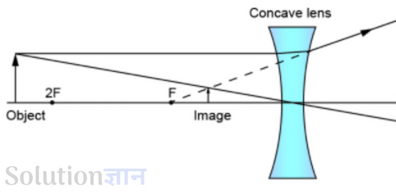
(b) Ray diagrams of the virtual images formed by using a convex lens
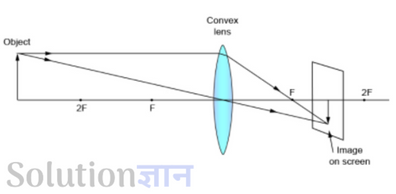
E. Answer the following questions.
1. A coin is placed at the bottom of a clear glass vessel. An observer moves herself to a position where the coin goes just out of sight of her eyes. Keeping her eyes in that position, she asks her friend to pour some water, gradually into the glass vessel.
(a) What would she observe?
Answer: Once water is filled in the vessel, the coin becomes visible to the observer.
(b) Name the phenomenon involved in this observation.
Answer: Refraction of light.
(c) Draw a neat labelled diagram to justify your answer.
Answer: A coin at the bottom of a (initially empty) cup, (that was not visible to the eye) becomes visible after some water is poured into the cup.
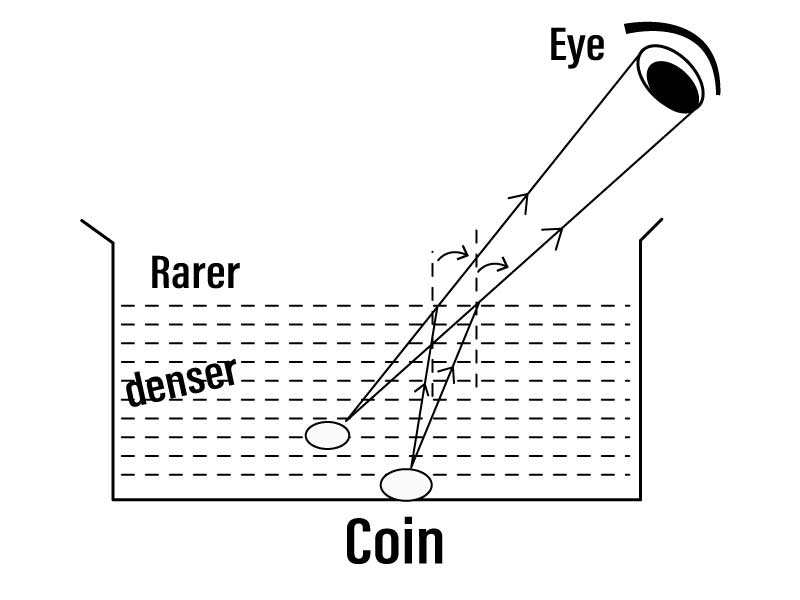
2. In the following figures, identify the light ray that would be the correct emergent/refracted light ray in each case. Give reason for your answer in each case.
Answer:
In case of Fig (a), P is the emergent ray because when a ray of light passes through a glass slab then it bends downwards.
In case of Fig (b), R is the emergent ray because light ray bends towards the normal when it enters a denser medium from a rarer medium.
In case of Fig (c), R is the emergent ray because light ray bends away from the normal when it enters a rarer medium from a denser medium.
3. White light is made to fall on one face of a glass prism. Draw a ray diagram to show the nature of the emergent beam.
Answer:
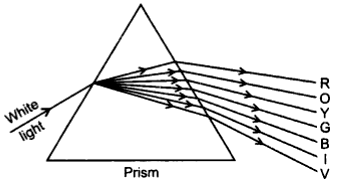
4. With the help of a suitable diagram, explain the meaning of terms: (a) centres of curvature (b) optical centre (c) focus
Answer:
(a) Centres of curvature: A lens is generally made up of two curved surfaces. These curved surfaces are parts of spheres. Centres of these spheres are called the centre of curvature. Here, C1 and C2 are the centres of curvature.

(b) Optical centre: The centre inside the lens is called optical centre. A ray of light passing through the optical centre emerges without deviation.
(c) Focus: When rays of light parallel to the principal axis, they converge at a point in case of convex lens. In case of a concave lens, they rays appear to diverge from a point. This point is called the focus of the lens.
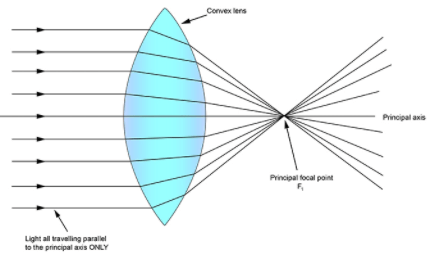
5. We are given a convex lens of focal length 20 cm. Draw ray diagrams to show the nature, size and position of the image formed when the object is kept at a distance of (a) 55 cm (b) 35 cm (c) 15 cm from the lens. (Note: For drawing ray diagrams, use an appropriate scale.)
Answer:
(a) Ray diagrams to show the nature, size and position of the image formed when the object is kept at a distance of 55 cm.
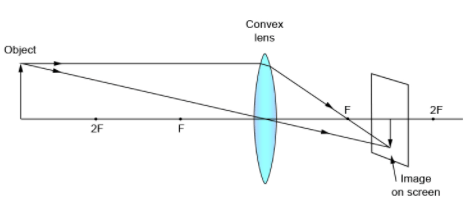
(b) Ray diagrams to show the nature, size and position of the image formed when the object is kept at a distance of 35 cm.
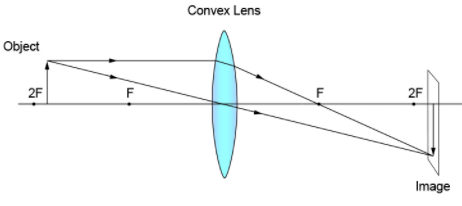
(c) Ray diagrams to show the nature, size and position of the image formed when the object is kept at a distance of 15 cm.
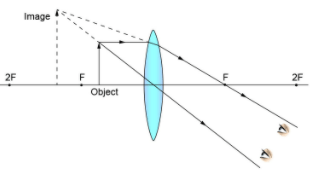
6. We are given a concave lens of focal length 15 cm. Draw a ray diagram to show the nature, size and position of the image formed when the object is kept at a distance of (a) 30 cm (b) 15 cm (c) 10 cm from the lens. (Note: For drawing ray diagrams, use an appropriate scale.)
Answer:
(a) Ray diagrams to show the nature, size and position of the image formed when the object is kept at a distance of 30 cm.
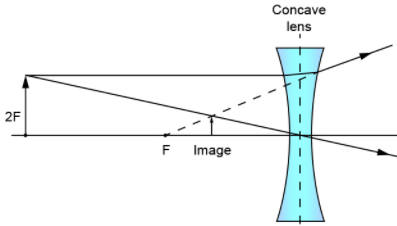
(b) Ray diagrams to show the nature, size and position of the image formed when the object is kept at a distance of 15 cm.
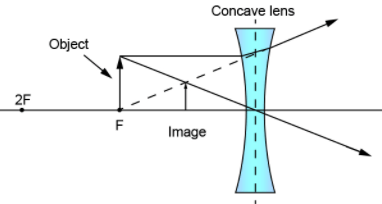
(c) Ray diagrams to show the nature, size and position of the image formed when the object is kept at a distance of 10 cm.
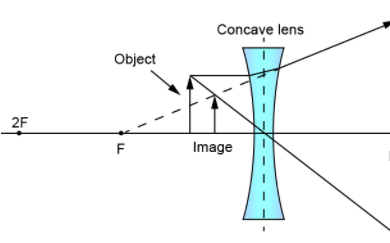
7. What type of a lens is used as a ‘magnifying glass? How is the object positioned with respect to this lens? Draw the appropriate ray diagram.
Answer: A convex lens is used as a magnifying glass. Object is kept between F and O to get a magnified image.
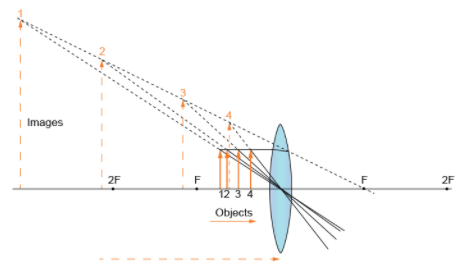

Yuhhhh
I like this webdsite brooo
Thanks You Sir.Very Help Full for us.
Value based bhi solution me dal dijiye
Sir
Give the answers of value based question .
very nice website
very nice website i like this website because it has all quetsion answers of DAV public schools best website. Thank you very much for this website
Thank you ! Sir
Yess thanks sir for your support
Thankyou sir it helps a lot thankyou very much
I request the creator to make an app for this content so we guys can download the pdf and can read whenever we want.
Thankyou sir it helps a lot thankyou very much